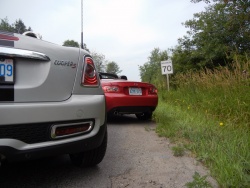 Mini Cooper S Roadster and Mazda MX-5. Click image to enlarge |
|
First Drive: 2012 Mini Roadster
Manufacturer’s web site |
Review and photos by Jonathan Yarkony
Photo Gallery:
2012 Roadster comparo
Roadsters.
It brings to mind top-down cruising on winding country roads with the sun beating down and exploring that connection between man, machine, and road.
Well, earlier this summer we did exactly that with a 2012 Mini Cooper S Roadster and the quintessential roadster, the king of roadsters, the all-time bestselling roadster of all time, the 2012 Mazda Miata-MX-5-Miata. What are they calling it again this year? Is it okay to call it a Miata again? Whatever.
For over 20 years now, the Miata has been The roadster, and I find it slightly presumptuous of Mini to come along and simply claim the Roadster name with their “Oh, look at us, we have such simple names for our cars, but then we confuse you with trim names…” Yeah, well, if you’re going to call yourself a Roadster, you better be prepared to face the best, and the Miata is the best.
I’ve driven Miatas and MX-5s on the track (and off, oops) on the road and off the map, and it has never been anything less than spectacular. Perhaps the best driving experience I have ever had was driving a Titanium Gray Metallic 2004 Mazdaspeed MX-5 down Maui’s twisting, coastal Hana Highway, and then back up again, then down and up and down and up and down and up again. An MX-5 is also the car I took my first track lessons on and it seemed to teach me not only the track but how to drive and how to appreciate every curve and turn.
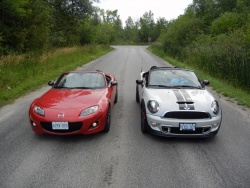 Mini Cooper S Roadster and Mazda MX-5. Click image to enlarge |
While my personal history with the Mini Cooper S is not as rich, I have driven it in various body styles at various times, and it, too, has done nothing less than bring sheer driving joy with every tug on the steering wheel, flick of a switch, and whoosh of a turbocharger. While Mini brand history goes back decades, the Roadster finds its roots in the modern Mini, relaunched in all its retro glory by BMW, the maker of cars that fulfill an extraordinary driving experience. Used to, at least.
The Roadster joined the Mini family just this year, and brings all the charm of Mini’s signature goofiness to the sporty, two-seat convertible market. Mini also builds a four-seat Convertible (yes, that is its model name) that offers a similar driving experience if you’re looking for a little more practicality.
But practicality is one of the last things that these cars are about. Roadsters are about driving pleasure, connecting with nature (at least the sun and wind, preferably we can avoid trees and water parts of nature), and driving pleasure. And with that, let’s get into these cars and have some pleasure (and hopefully that didn’t sound too creepy).
2012 Mini Cooper S Roadster
Okay, those of you who are used to our Comparison Test format might be thinking at this point, “Ah, the Mini lost, it just can’t compare with the perfect balance and ideal layout of the RWD MX-5.” And you’d be right. It can’t. It is a wholly different beast.
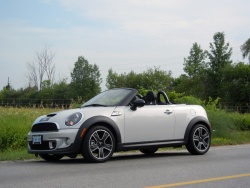 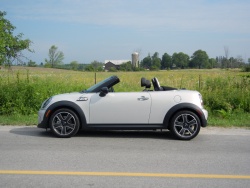 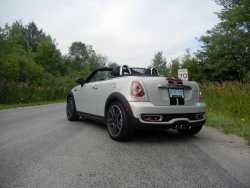 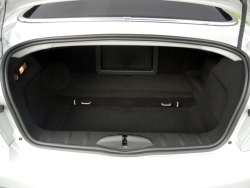 Mini Cooper S Roadster. Click image to enlarge |
The Mini arrives at its magic in one of the most distinct and polarizing packages in the automotive world. It is unlikely that you will mistake a Mini for anything other than another Mini, so strong is the family resemblance between their models, and so unique is their adorable mug. With wheels at the absolute limits, big, googley-eyed headlights, and a tiny footprint, the Roadster carries the Mini brand look and offers a blister on a brick look with the roof up, and looks a bit like an anvil with a windscreen with the top down, and it feels just about as solid. That windshield is well secured, too, with almost zero cowl shake over even rough roads. However, that solid chassis comes at the price of weight–1,245 kg for a car this size is pretty hefty.
Trunk space is good for a weekend getaway (240 L), but you’ll be leaving the golf clubs at home (likewise with the MX-5) and paying full attention to your partner on any road trips, not only because of the lack of golf clubs, but also because of the close quarters. You’ll be rubbing elbows with your passenger most likely, but it’s a fun cabin to spend time in, and anyone who allows their inner child to come out and play will be flicking each and every toggle switch to find out what it does before trying to decipher the pictograms. Then again, if you just want to lower a window, you might spend more than the usual half-second locating the switch… In general, the controls are awkward and trickier to use, but well worth the charm factor in my opinion, and Mini masks some of the chintzy plastic with funky design, which may not be to everyone’s tastes. Then again, this was never a car that needed to cater to the Camry and Civic masses.
The steering wheel, however, is a hefty piece, and while it carries on the look of round things, it steers the front wheels with sharpness and immediacy and returns all the information one could ever want about a road. Steering isn’t feather light, nor is it needlessly heavy, offering up only enough resistance to make sure you really mean it, and reciprocating with even, accurate, and lightning quick changes in direction and clear feedback when the front tires stand to lose traction.
On the roads of central Ontario, there are too few curves to excite drivers, but the Roadster is a joy on a hot summer day, enjoying the sun, or closing the top for a respite from the sun and A/C blasting on high. The Mini’s roof is a soft top, but if anything, it seems quieter than the MX-5 with the roof up, which has a tendency to echo engine and mechanical sounds–a plus in some people’s books, but the Mini is a ‘premium’ brand so its refinement is fitting.
Put the Mini back in the city and every turn, lane change, or tight parking lot becomes an exercise of imagining the city as a go-kart track. At low speeds or on the highway, the Cooper S has the power delivery to slot into gaps as soon as you see them if you’re keeping the boost well primed–if you’re not, you’ll have to wait out a bit of turbo lag.
The Mini’s 1.6L four-cylinder engine no longer seems so small now that compact cars like the Cruze and Dart are coming to market with turbocharged 1.4L engines. The Cooper S’ 1.6 is turbocharged and intercooled, and makes 181 hp and 177 lb-ft of torque from 1,600 rpm to 5,000 rpm. This engine is enough to claim a 7.1 second time for 0–100 km/h with the 6-speed manual transmission, as equipped for this test. The clutch is a touch firm, and the shifter’s throws a bit long and seem a bit rubbery next to the MX-5’s, but is still a joy to operate.
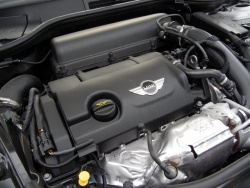 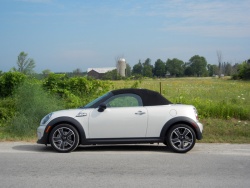 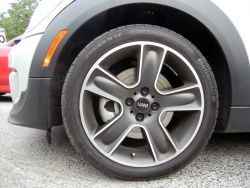 Mini Cooper S Roadster. Click image to enlarge |
The engine’s noises will also amuse with various exhaust barks, turbo whooshes and hisses, and a generally raucous soundtrack that will have you pressing the Sport mode button for the more aggressive tune on every trip. Power delivery is also a touch more urgent in this mode, but the difference isn’t hugely noticeable in most driving conditions, moreso because the standard mode is so much fun already that there seems little to improve upon.
Our Cooper S Roadster also featured an upgrade to 17-inch black-star bullet wheels, which really fit the car’s playful yet personality, and added to the grip in acceleration, turning, and braking. Brakes are sharp and strong, but recent experiences make me think that they would not be track-grade if even the JCW [hyperlink] models’ brakes start smoking before the lunch break on a track day.
And being a small car, the Mini Roadster delivers standout fuel consumption estimates, though if you match NRCan’s 7.6 L/100 km city or 5.6 highway ratings with the manual transmission, well, I would hazard to say that you’re not doing it right. While we didn’t record fuel consumption of the drive route, a recent week in the Cooper S Roadster yielded 8.0 combined, but that was before I drove it across the city like I had a load of gold to deliver.
You’ll need that load of gold, too, if you start piling on options, because Mini offers a seemingly endless list of features, modifications, and accessories. The base price of $32,900 can easily climb into the $40s, and if you keep at it, I’m sure you could creep into the $50s, especially if you wanted the added power, prestige, badges, exclusivity, and more badges of the John Cooper Works Roadster. But really, the Cooper S is every bit as fun, if not quite as fast or hard-edged as the JCW.
However, the Cooper S is the faster and harder-edged choice than the other car in this comparison, the MX-5, which goes about its roadster business with a slightly more relaxing experience that could easily be described as mature. So if you want the hooligan delinquent to reign terror in the city, well, the Cooper S would be my choice, but for that quintessential drive through the countryside, keep reading.
2012 Mazda MX-5
As similar as these cars might be to a casual observer (small, two-seat, fun, sporty convertibles) it is amazing how they arrive at it with such essential and significant differences: front-wheel drive vs rear-wheel drive; turbocharged vs naturally aspirated; soft top vs hard top; goofy and funky vs classy and timeless.
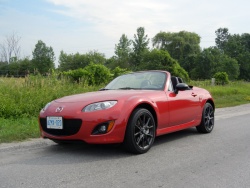 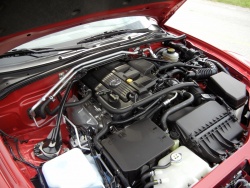 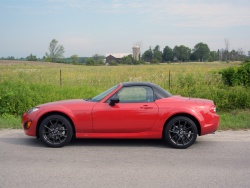 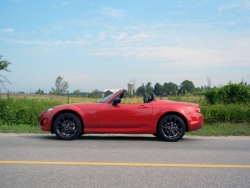 Mazda MX-5. Click image to enlarge |
Okay, that last might be descending into subjective territory, but few will dispute that the MX-5 adheres to a more traditional design and performance philosophy. While some of its bulges and creases are thoroughly modern, there is an elemental simplicity to its shape and proportions that would seem at home next to Triumph, MG and Alfa roadsters of the past while the Mini would look like a goggle-eyed, interloping whipper-snapper.
It’s also a car I could actually afford, starting at $29,145 and climbing into the low $40s for a fully loaded automatic GT. But this is a car that no one should buy with an automatic, because the six-speed manual transmission and clutch are two more connections to this iconic sports car.
That’s right, I said it. Sports car. Take your 911s and your Corvettes and your Elises and your Toyobarus (or give them to me, I’d be plenty happy with any of those, too) and the MX-5 is, pound for pound and horsepower for horsepower and dollar for dollar also one of the greatest sports cars, ever. Is it better than them? To each their own, but for me, the best one is whichever one of those I happen to be driving at any particular moment. However, the MX-5 would be my choice among cars with less than 200 hp and starting for under $40k (note how I avoided the FR-S/BRZ by saying under 200 hp–I don’t think I could ever choose between those two, er, three).
While its 2.0L naturally aspirated four-cylinder’s 167 horsepower seems downright paltry in this day and age of 650-hp Mustangs and 280-hp V6 family sedans, the MX-5 is happy with that kind of power, carrying 1,115 kg at its lightest and 1,182 kg as tested in SV trim with a power retractable hard top and manual transmission. This may be light for a modern car, but it is not light for a Miata, and one of the major revisions for the next generation (rumoured to be arriving as early as 2014) will be SkyActiv weight savings.
Even without the SkyActive treatment, the MX-5 sips gas thanks to its small displacement and low power ratings. NRCan estimates peg it at 9.7 L/100 km in the city and 7.1 on the highway, and in other test drives we’ve managed anywhere from 7.9 (on a mostly highway road trip) to almost 10, so the Mini might be your better efficiency choice until the MX-5 has gone on its SkyActiv diet.
Not only is the power meagre, but it arrives only at 7,000 rpm, and peak torque of 140 lb-ft long past at 5,000 rpm. Is this a problem? No, this is the solution.
You see, there’s this little thing that you’re supposed to do with a car, called “driving”. It’s when you use the pedals (all three of them, preferably), the gearshift lever, and steering wheel to make a car go, and preferably go fast. Some people might call it ‘work’ but we call it ‘pleasure’, and many of you, like me, would drive hundreds of kilometres out of our way, then pay extra money on top of the gas bill, just to drive around in circles–or at least interesting shapes with lots of curves that end up in the same place–over and over again.
The MX-5 is definitely one of those cars that you will want to take to track days. On the way there, the ride might seem a bit rough, though not as rough as the Cooper S’. If you travel with the roof up, there will be wind and mechanical noises to drone away and grate on your nerves, and with the roof down, even more wind noise to drown out just about everything else, although below highway speeds it is not unpleasant, just typical convertible rush. And while neither is a quiet, cosseting ride, the MX-5 offers a slightly more comfortable setup and is a bit more relaxing when just cruising along.
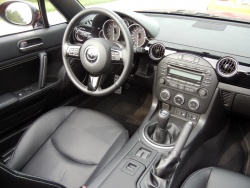 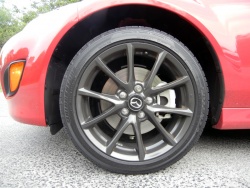 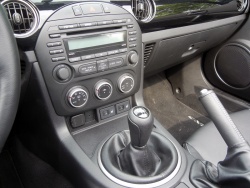 Mazda MX-5. Click image to enlarge |
The interior is plain, black plastics, but the controls are dead simple and clearly marked, if lacking in visual or tactile appeal. The hardtop is also power operated, compared to the Mini’s manual soft top, though enthusiasts will stick with the manual soft top, and only masochists will avoid the price to add A/C, which only adds 15 kg.
The manual transmission, a six-speed in our test car, but a five-speed in base models, is one of the best manual transmissions anywhere. While it is not my personal favourite, at a recent automotive event, half the automotive journalists at our table picked the MX-5 as the “bestest, most awesomest manual transmission ever.” Okay, they didn’t exactly say it like that, but for me, the shifter in the Honda S2000 was my all-time favourite, and the Honda Civic Si is still my current favourite (a shame about its unfortunate FWD condition), and I was not alone at the table with that choice. Suffice to say, this transmission is awesome, with properly short throws, medium effort clutch, and throws that notch into gates with slightly rough mechanical solidity. The Mini just doesn’t hold a candle to this gearbox.
Despite the power disadvantage, the MX-5 with hardtop and six-speed manual can reach 100 km/h in 7.8 seconds, though you can bring that down to 7.5 if you ditch the hardtop. Not numbers to set hearts aflutter and not as fast as the Mini, but still plenty quick about town, and enough to get going on a track. Power delivery is more even than the Mini because of the naturally aspirated engine, but it never delivers as much of a surge of power even at its strongest, but with six gears, you always have the right gear at your disposal to keep it close to its sweet spot.
But the magic of the MX-5 isn’t in the acceleration. It is in deceleration and cornering. The four-wheel disc brakes clamp down on 290 mm rotors in front and 280 mm in back, the 17-inch wheels (in a smoky dark grey as part of the SV trim) with 205/45R17 rubber bites into the asphalt, while the front double wishbone and coil springs absorb the shifting mass and keeps the back end down on its multilink rear suspension to keep the rear drive wheels well planted and ready to apply power on corner exit. Whether on a track or a winding country road, the MX-5 loves corners, and makes you love corners.
While the steering isn’t as crisp or immediate as the Mini, it is perfectly linear and communicative, allowing precise control at any point in any turn. And because of its RWD layout, the MX-5 offers the added pleasure of throttle steering–dialling in more throttle to put more weight on the back end to push the car through corners or easing off throttle to rotate the car on its longitudinal axis and force more weight onto the front tires for better turning grip. In a FWD car, the wheels just tend to spin more…
I’ve never been one to claim any great driving skill, or any driving skill at all, for that matter, but the engine sends all its information to the pedals and shifter so well that a tach seems redundant, the pedals are well positioned for heel-toe downshifting (same goes for the Mini on that count), and every motion of the MX-5 and every moment of grip is communicated from the chassis through to the seat and steering wheel, that it all comes together like a revelatory experience–you just know what the car is doing and know what to do with the car. As good and as direct as the Mini is, it falls just a little short of the divine as in the MX-5.
If that’s not enough to win a comparison, I don’t know what is.














